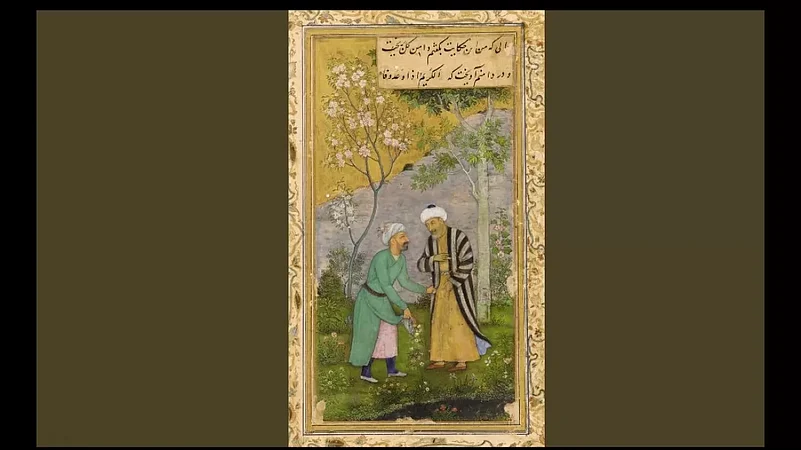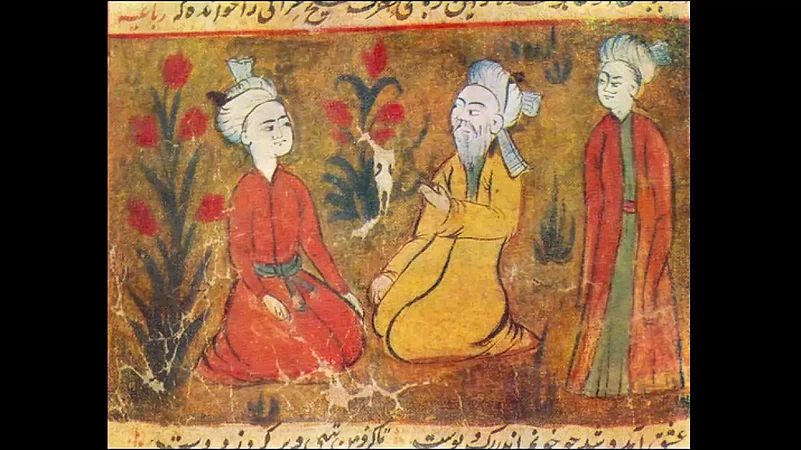Look at a chickpea in the pot, how it leaps up when it is subjected to the fire.
At the time of it being boiled, the chickpea comes up continually to the top of the pot and raises a hundred cries,
Saying, “Why are you setting the fire on me? Since you bought (and approved) me, how are you turning me upside down?”
The housewife goes on hitting it with the ladle. “No!” says she: “boil nicely and don't jump away from one who makes the fire.
This imaginary conversation between the chickpea and the housewife appeared in Rumi’s Persian magnum opus The Masnawi, in which he has frequently used fables and parables from Panchtantra to describe the mysteries of spiritualism and human characters. Rumi started writing The Masnawi in 1258, Panchtantra—the ancient Indian collection of animal fables in Sanskrit—was written in 1200 BC.
The historical relationship between India and the Persian world, including contemporary Iran, Afghanistan and Central Asia, has existed since the inception of human civilisation. The symbiosis between the two is beyond our estimation and assessment.
The journey of our civilisation cannot be fully understood without connecting with the history and traditions of the Persian world. Our history and cultural geography are inseparably interwoven with the Persian world, especially Persia (contemporary Iran).
Persian—the sister-language of Sanskrit—is deeply connected with Indian languages, cultural traditions, history and various other aspects of the Indian civilisation. It has played a vital role in the evolution of almost all modern Indian languages and their literature.
The deepness of its influence can be realised through everyday words that have become a part of our identity. Hindi, Hindu, Punjabi, Khalsa, sardar, adalat, zameen, bazar, ghazal, zaban, adami are just a few examples.
Persian poetry has had a strong influence on poets from the Indian subcontinent. Almost all poets of the last millennium bear the influence of Persian classical poetry. These include Amir Khusrau, Kabir, Malik Muhammad Jayasi, Quli Qutub Shah, Bulleh Shah, Mir Taqi Mir, Mirza Ghalib, Muhammad Iqbal, Rabindranath Tagore, Sumitranandan Pant, Harivansh Rai Bachchan and Kazi Nazrul-Islam.
Masud Saad Salman and Abul-Faraj Runi, the earliest poets from Persia, were Indians and lived in Punjab. Rumi’s The Masnawi was popular among Indian Sufis and scholars. The most number of commentaries on The Masnawi were written in India. The most voluminous ones were by scholars Ajmal Allahabadi, Mawlana Bahrul-Uloom and Mawlana Ashraf Ali Thanvi.
While browsing through our literary traditions or reading Sufi-Bhakti poetry, we come across many Persian poets from Iran like Ferdowsi, Omar Khayyam, Nizami Ganjavi, Attar, Mawlana Rumi, Saadi Shirazi and Hafez. There are many examples of the influence of Persian work in India and vice versa.

The influence of Panchtantra, Ramayana, Mahabharata
The story of the translation of Panchtantra in Pahlawi (a foreign language) by Borzūya in the sixth century and how it influenced Persian and Arabic literature is an inseparable part of the Indo-Persian cultural-literary history. Bu Ali Shah Qalandar, the famous Sufi of Panipat, was one of the students of Mawlana and composed poems in his style.
Poets of Sufi-Bhakti tradition frequently take inspiration from The Masnawi. This can be seen even among modern poets and spiritual movements like the Radha Soami tradition. Many Indian poets of Persian and Urdu, like Sheikh Sarfi of Kashmir and Allama Iqbal, are known as the spiritual disciples of Rumi.
Ferdowsi has described the cultural connect of the Persian world with India in his great epic Shahnameh. It can also be seen in Ramayana and Mahabharata. According to some scholars, Kaiykeyi, the stepmother of Shri Ram, probably bears the name of Iranian royals as they used to have names like Kai-Khusraw and Kaikaus. Similarly, there is a character named as Arash in the Shahnameh, very similar to Arjun of the Mahabharata.
The great epic poet Nizami Ganjavi’s magnum opus Khamsa—a bunch of five epics—has inspired many poets. It is said that over two hundred poets tried to recreate Khamsa, but only a few were successful. Amir Khusraw from India, Amir Ali Sher Nawai from Uzbekistan and Mawlana Jami from Herat were among the few. Nawai and Jami were the followers and admirers of Amir Khusraw.
Omar Khayyam’s India Connection
Omar Khayyam, the great philosopher and poet, was always known as a mathematician and astronomer among academics globally, but the modern discovery of him as a poet, has an Indian connection. The credit to popularise him in the West and among the common masses goes to his British English translator Edward Fitzgerald, a poet from the 19th century. He came across Khayyam’s Rubaiyat during his visit to Calcutta and decided to translate it into English.
The translation became so popular among the British and the Europeans that many parks, clubs and wine centres were named after him. One of the reasons why he was so popular was because they perceived and connected his poetry to Epicurean ideas which suited the neo-rich European society.

This trend enthused Indians and Iranians, too, and his work was translated in many Indian languages like Sanskrit, Hindi, Urdu, Bangla, and other Dravidian languages. Some of the famous Indian poets and commentators who were inspired by Khayyam include Riyaz Khairabadi, Harivansh Rai Bachchan, Nazrul and Swami Yoganand.
Popularity of Saadi in India
Bani aadam aazay-e ek paikarand/Ke dar aafrinash ze ek gauharand
(Human beings are like limbs of the same body, as they are created out of the same component)
This couplet by Sheikh Saadi of Shiraz, a great poet and writer from Iran, is inscribed on one of the walls of the United Nations to pay tribute to the great humanist and Sufi poet. He was known as moallim-ul-akhlaq (the teacher of ethics) and was popular in India and across the world. His books Gulistan and Bostan are used as textbooks of Persian in schools and colleges across the globe, and since his own period in India, introduced first in Banaras.
He was invited by Prince Muhammad, the son of King Balban, to exalt his court in Multan on the instances of young court poets Amir Khusraw and Hasan Dehlawi. Though Saadi expressed his inability to oblige due to his advanced age, he was all praises for Khusraw.
Hasan Dehlawi, a successful follower of Saadi, was later called Saadi of Hindustan. The first monograph on the life and works of Saadi titled Hayat-e-Saadi was written by famous Urdu poet Altaf Husain Hali. Later, famous Hindi-Urdu fiction writer Premchand wrote a brief monograph on him in Hindi, titled Mahatma Saadi.
Hafiz of Shiraz, globally recognised as the master of ghazal and one of the finest poets of human history, is also recognised as the symbol of the poetry itself. Dante, the great German poet, took inspiration from Hafiz while composing his magnum opus. Hafiz inspired and influenced a great number of Persian poets. He had become a legend during his lifetime.
Hafiz was an admirer of Amir Khusraw, and called him Tuti-e-Hind (the parrot of India). The contemporary Indian ruler of Bengal Sultan Ghiyasuddin Azam Shah (1390-1409 AD), invited him to join his court. He started the journey but encountered a sea storm. It discouraged him and he returned to Shiraz. He later sent a ghazal to express his regrets and show his admiration for Indians.
Shakkar shikan shawand hama tutiyan e Hind
Zin qand e Parsi ke be Bangala mi rawad
(May all the poets or parrots of India become the poets of saccharinity, as this Persian sweetness has reached Bengal)
The presence and popularity of his poetry among Bengalis is unfathomable. From the Mughal emperors, princes, princesses, and nobles to all educated people, Sufis to agnostics, Mullas and Pundits, poets and worriers of different periods and centuries loved and admired him alike. Debendranath Tagore, the Brahmo Samaj spearhead and Rabinder Nath Tagore’s father had memorised the whole Divan of Hafiz, and, at the time of his death, had asked his disciples to recite verses from the Bhagwat Gita and Divan of Hafiz.
During his visit to Shiraz, Tagore was affectionately called Hafiz-e-Hind (the Indian Hafiz) by the people. Tagore invited Iranian professor Dr Pouredaud to teach Old Persian in the Viswa-Bharati University at Shantiniketan.
Khusraw, Bedil and Iqbal
Among the Indian Persian poets, Amir Khusraw, Mirza Bedil and Iqbal are the most popular among the people of the Persian world. In Afghanistan, a group of Bedil’s admirers call themselves Bidiliya and organise weekly meetings to recite and discuss his poetry.
In recent years, Bedil has become a household name in Iran, too. He has inspired the stylistics of modern Persian poets like Sohrab Sepehri, Ahmad Azizi, Ali Moallim and others. Khusraw is counted among the greats of the classic era, and Iqbal earned his recognition as a philosopher and poet of the Modern Age.
Unfortunately, Ghalib, a Persian poet of great merit, and many others like him, couldn’t get the due recognition because of the colonial intervention, followed by the literary and cultural disconnect in the succeeding period, besides other reasons like semantic nuances.
Unlike most Asian and African countries, Iran was never directly colonised by Europe. Nonetheless, Iranian society and literary circles received and followed the new literary trends during the late nineteenth and early twentieth century. They too preferred genres like short-story and novel writing and did not follow classical legends in the prose.
Sher-e-Nau (new poetry)
In the same period, the poets deviated from classical genres of Persian like Qasida, Ghazal, Masnawi and its prosodic boundaries to adopt new form and themes of poetry. They called it Sher-e-Nau (new poetry). Nima was the initiator of this trend. Soon, many followed.
Some of the prominent followers of this trend were Akhwan, Ahmad Shamlu, Nadir, Shafiei Kadkani, Faridoun Musiri, Sohrab Sepehri and Forughe Farrokhzad. Later, poets like Shamlu introduced further modifications into Sher-e-Nau, and moved towards blank verse or prose poetry.
Women Poets
The presence of women in Persian poetry can be seen from the time of Rabia Qozdari—the first woman poet in the early era—to the contemporary period. Since Qozdari’s time, poetries have been a way of expressing the assertion of women’s aspirations. This aspect could be seen in the works of poets from the previous eras like Mahisti Gilani and Zaibunnesa Makhfi—the daughter of Aurangzeb.
Contemporary women Persian poetry candidly and potently presented the problems, pains, agony and aspirations of women. They were also a voice of rebellion against age-old subjugation and superiority of patriarchy. The tradition of women’s writing in contemporary Iran is thus one of radical dissent and questioning. It is the chronicle of an evolving consciousness; the testament of efforts to make lives according to the new values and standards.
Despite the societal obstacles that identified women as wives and mothers and idealised their invisibility and voicelessness, towards the middle of the nineteenth century, a tradition of women writers came to be established in Iran.
The first among them was Farrokhzad (1935-67). An effervescent and maverick poetess, she rejected the traditional patriarchal expectations and became an icon of women’s voice of non-conformity. Instead of being the voice of her individual world, she also tried to understand society comprehensively and became conscious of the great common spirit of mankind:
They were drowned in their own fright
And the frightened sense of sin
Had paralysed
Their blind, dumb souls...
("The Earthly Verses", Born Again)
Other poetesses and women writers like Simin Behbahani, Shahrnush Parsipur, Simin Daneshvar and others have emerged in the literary scenario and have successfully advocated the issues and anguish of women. The post-revolution era has seen a feminist movement in Persian Literature that has had a great impact on the minds of the people. Their writings have inspired a change in society.
(Akhlaque A ‘Ahan’ is an Urdu-Persian poet, professor and chairperson at the Centre of Persian & Central Asian Studies, Jawaharlal Nehru University)
















